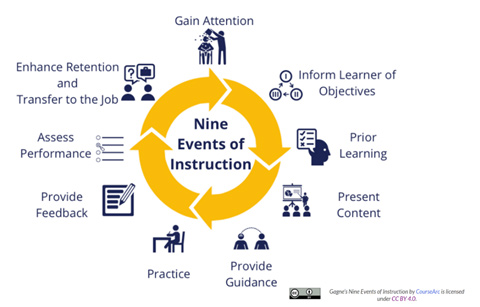Designing learning activities
Learning activities need to align with their assessment, with the learning outcomes for the course/program overall, and with the students’ needs at this stage of their learning.
Planning learning activities
When planning learning activities, you should consider the types of activities that students will need to engage in to achieve and demonstrate the intended learning outcome/s. The activities should provide experiences that will enable students to engage, practice and gain feedback on specific outcome/s.
Some questions to think about when designing the learning activities:
- What would motivate your students to do these activities?
- What do students need to hear, read, or see to understand the topic?
- How can I engage students in the topic?
- What are some relevant real-life examples, analogies, or situations that can help students explore the topic?
- What will students need to do to practice and demonstrate knowledge of the topic?
Diana Laurillard (2012) classified learning activities into six types: acquisition, inquiry discussion, practice, collaboration and production.
| Acquisition | Learning through acquisition is where students explore ideas provided by their teachers. For example:
|
|---|---|
| Inquiry | Student learning through investigation explore, compare, and critique texts, documents, and resources they find that reflect the concepts and ideas being taught. Inquiry can include visiting spaces, online research, data analysis, comparing and contrasting texts. |
| Discussion | Learning through discussion requires the learner to articulate their ideas and questions and respond to the ideas and questions from their teachers and/or from their peers. Discussion can include: in-class discussions, group discussions, online asynchronous forums, polling, think-pair-share activities. |
| Practice | Learning through practice requires learners to respond to tasks set by teachers and adapt their actions to the task goal, and use the feedback provided to improve their next action. Practice can include: problem sets, quizzes, role-plays, and games. |
| Collaboration | Students work together to understand and respond to a problem as a group. Collaboration is about the process of working together. Students negotiate their ideas and practice. Collaborative learning is most effective when students challenge each other and provide peer feedback to develop the best output they can. Collaboration can include: small group work, project work, collaborative problem solving, jig-saw grouping. |
| Production | Learning through production is when students must produce an output set by the teacher. Production motivates the learner not through the response from the teacher but in the production of a public output. Production can include: blogging, developing models or artefacts, video or audio performance, e-portfolios, concept mapping and writing. |
Laurillard, Diana. (2012). Teaching as a design science. In Routledge, Taylor & Francis Group. Routledge.
Lesson planning
Robert Gagne proposed a nine-step process called the events of instruction, which is useful for planning the sequence of your lesson.

Source: Lesson planning, Singapore Management University Centre for Teaching Excellence.
A lesson plan contains the details of what students need to learn and how it will be done effectively during a class.
A successful lesson:
- considers the social, physical, personal, and emotional needs of the student
- is aligned with the graduate attributes of the institute where the course is being taught
- has clear and well-defined learning outcomes
- has a sequence of learning activities that help students master the proposed learning outcomes
- provides students with the ability to be actively involved in the session
- promote creativity, critical thinking, communication and collaboration in the classroom
- includes formative assessments to check for student understanding
- enables educators to collect data about the learning process and learning experience of the students.
Before the class
- Identify graduate attributes
- Identify learning outcomes
- Plan the learning activities
- Plan to assess student understanding
- Create a realistic time plan
- Plan for lesson closure.
During the class
- Share the plan with students
- Effectively implement the plan
- Try to keep to the proposed time plan
- Try to collect data.
After the class
- Analyse collected data
- Reflect on what worked and what didn’t
- Redesign the lesson and the lesson plan.
Ready to Teach Week
Twice a year, ITaLI puts together a program of online and in-person activities designed to help you prepare course materials for the upcoming semester.
Need help?
ITaLI offers personalised support services across various areas including planning and designing learning activities.
